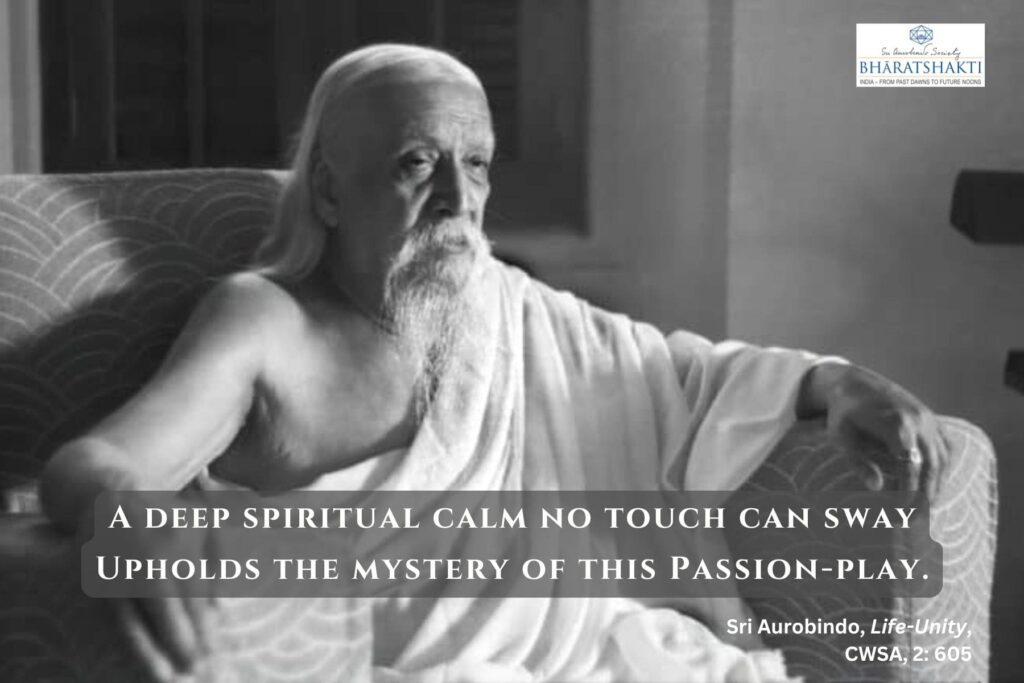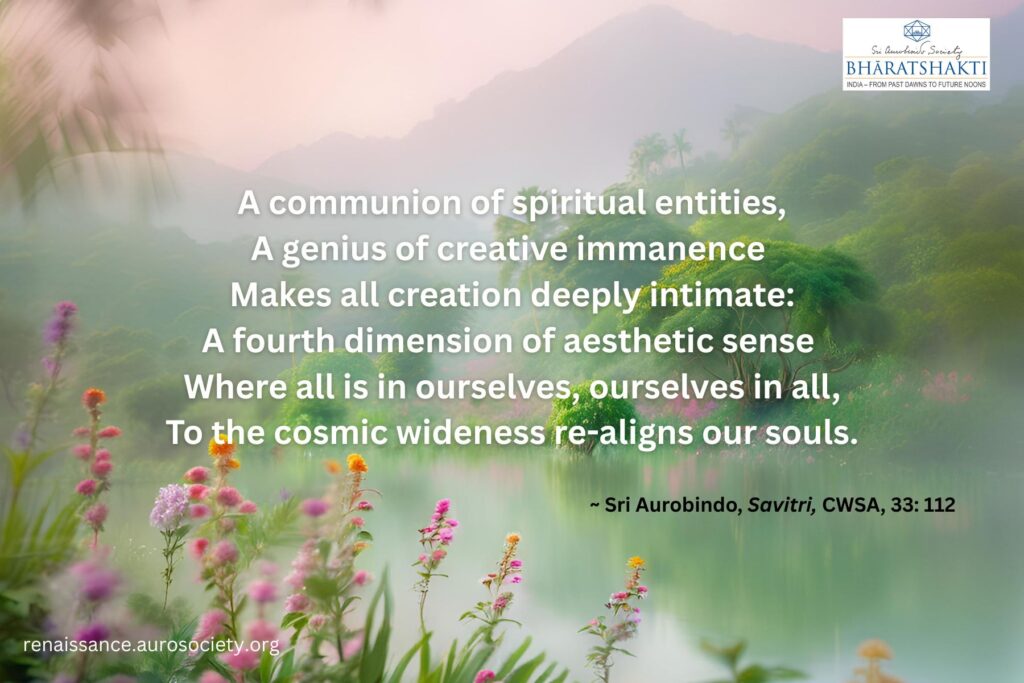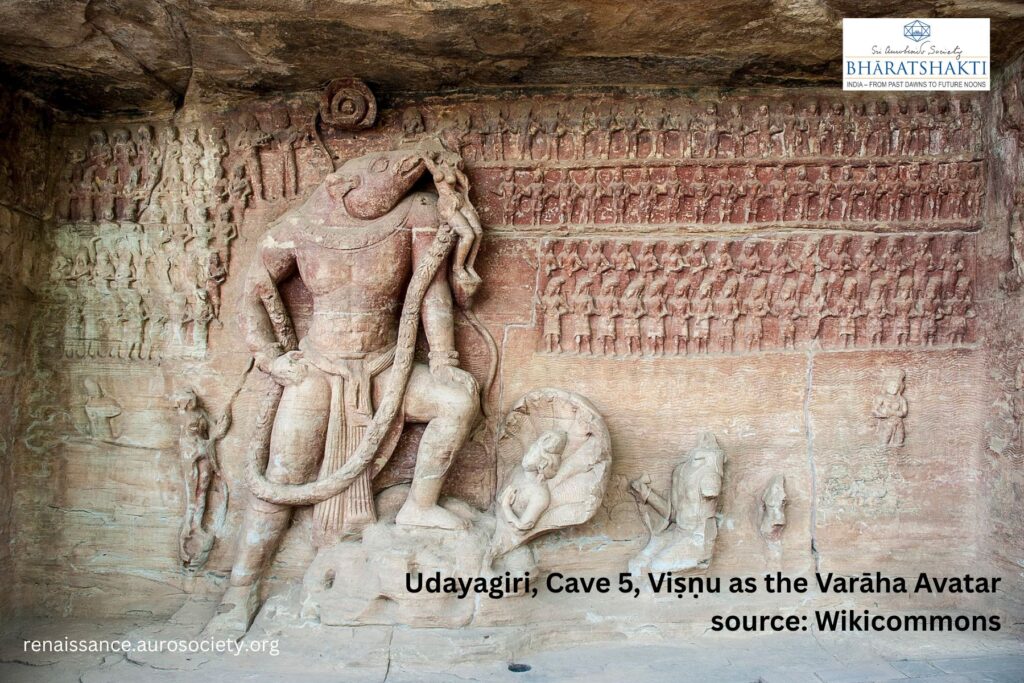Volume II, Issue 5
Author: M.P. Pandit
Continued from Part 3
We now come to the next set of verses, number 9-14.
अन्धं तमः प्रविशन्ति येऽविद्यामुपासते।
ततो भूय इव ते तमो य उ विद्यायां रताः ॥९॥
andhaṁ tamaḥ praviśanti ye’vidyāmupāsate |
tato bhūya iva te tamo ya u vidyāyāṁ ratāḥ ||
“Into a blind darkness they enter who follow after the Ignorance, they as if into a greater darkness who devote themselves to the Knowledge alone.” (CWSA, Vol. 17, p. 8)
अन्यदेवाहुर्विद्ययाऽन्यदाहुरविद्यया।
इति शुश्रुम धीराणां ये नस्तद्विचचक्षिरे ॥१०॥
anyadevāhurvidyayā’nyadāhuravidyayā |
iti śuśruma dhīrāṇāṁ ye nastadvicacakṣire ||
“Other, verily, it is said, is that which comes by the Knowledge, other that which comes by the Ignorance; this is the lore we have received from the wise who revealed That to our understanding.” (CWSA, Vol. 17, p. 8)
विद्याञ्च अविद्याञ्च यस्तद् वेदोभयं सह ।
अविद्यया मृत्युं तीर्त्वा विद्ययामृतमश्नुते ॥११॥
vidyāñcāvidyāñca yastadvedobhayaṁ saha |
avidyayā mṛtyuṁ tīrtvā vidyayā’mṛtamaśnute ||
“He who knows That as both in one, the Knowledge and the Ignorance, by the Ignorance crosses beyond death and by the Knowledge enjoys Immortality.” (CWSA, Vol. 17, p. 8)

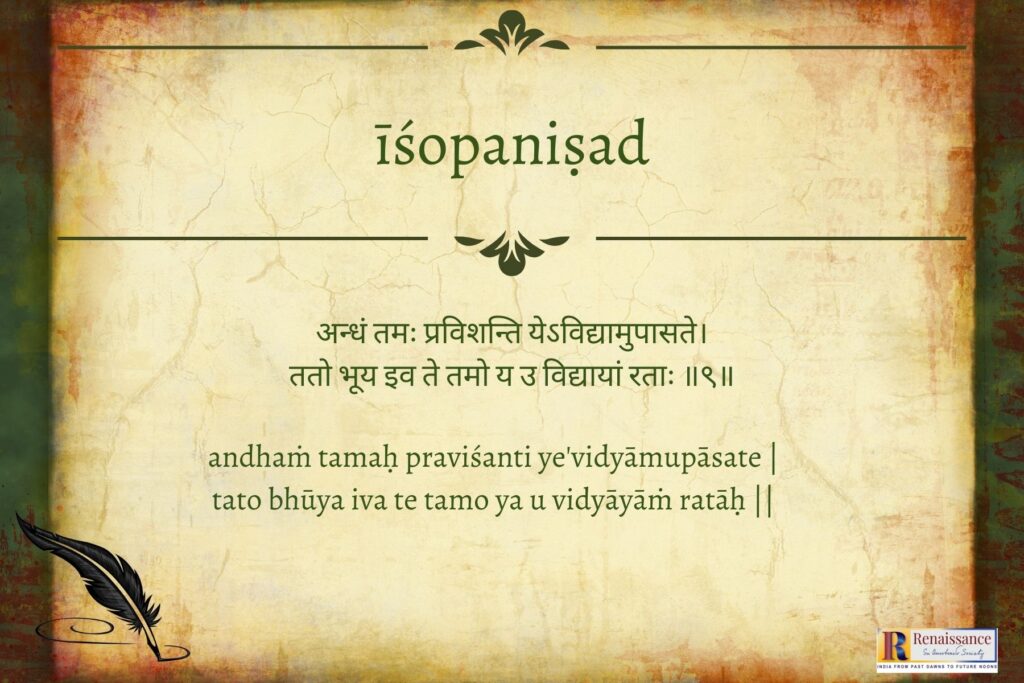

Knowledge, vidya, Sri Aurobindo explains, is the consciousness, the effective awareness of the Unity of things, the Oneness of all. Ignorance, avidya, is the consciousness of multiplicity.
Those who are aware of only the multiplicity of forms and not their reconciling oneness and live in line with that understanding are closed to the light of true knowledge and sink into obscurity. But those who look only at the Unity of things, the sheer oneness alone, denying the fact of the many, withdraw themselves gradually from the scene of life-activity and merge into a state of non-being, a state of consciousness where everything is, as if, iva, a blank of still greater darkness.
This sense of iva seems to be left out in the commentary of Shankara; there it is explained as eva, verily. The point is that this state attained by the pursuit of sheer unity alone is so void, that its emptiness resembles — though, be it noted, it is not the same — in its benumbing blankness, the darkness of Ignorance raised to a degree.
Sri Aurobindo explains:
Those who are devoted entirely to the principle of indiscriminate Unity and seek to put away from them the integrality of the Brahman, also put away from them knowledge and completeness and enter as if into a greater darkness. They enter into some special state and accept it for the whole, mistaking exclusion in consciousness for transcendence in consciousness. They ignore by choice of knowledge, as the others are ignorant by compulsion of error. Knowing all to transcend all is the right path of Vidya.
Although a higher state than the other, this supreme Night is termed a greater darkness, because the lower is one of chaos from which reconstitution is always possible, the higher is a conception of Void or Asat, an attachment to non-existence of Self from which it is more difficult to return to fulfilment of Self.”
(CWSA, Vol. 17, p. 53)
But rightly pursued and realised, the results of Knowledge and Ignorance, says the Upanishad, are different. They are both related to each other. Multiplicity is supported and sustained by the underlying Unity and Unity is realised in its full potential only vis-a-vis the multiplicity. The Many, the manifestation in diversity, provides the field for the soul to live and grow in the experience of a multitudinous becoming—in all its richness—and arrive progressively at a point where the impact of multiplicity begins to be informed and regulated by the consciousness of the governing Unity—Vidya.
When one realises this Knowledge, not only in the mind but in other parts of the being, specially related to life-activity, the knot of Ignorance, the sense of separativity is lost and the range of one’s consciousness begins to transcend the barriers of the normal human existence — physical and other — in a word, it partakes of immortality. This is the truth seen by the ancients, the dhīrā-s who saw ‘steadfast in the gaze of their thought’ and revealed widely, comprehensively, to the seers of the Upanishad, vicacaksire.
So also, birth and non-birth, acceptance of manifestation and withdrawal from it are truths which yield their full value only when taken together and lead to disastrous results if followed exclusively. This, we see, elaborated in the next three verses of the Upanishad.

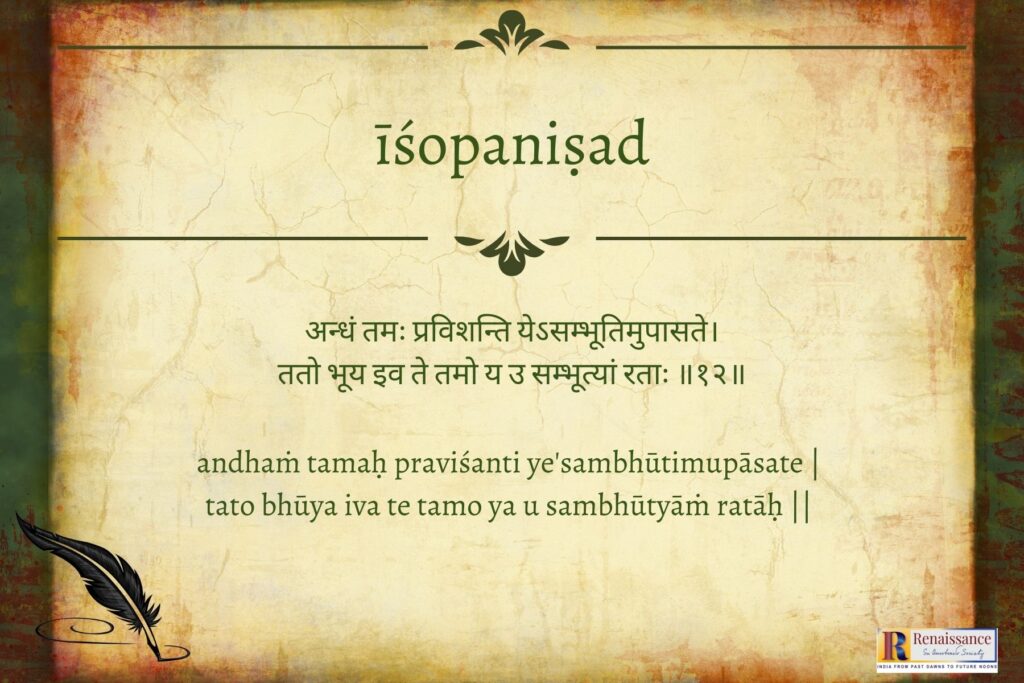
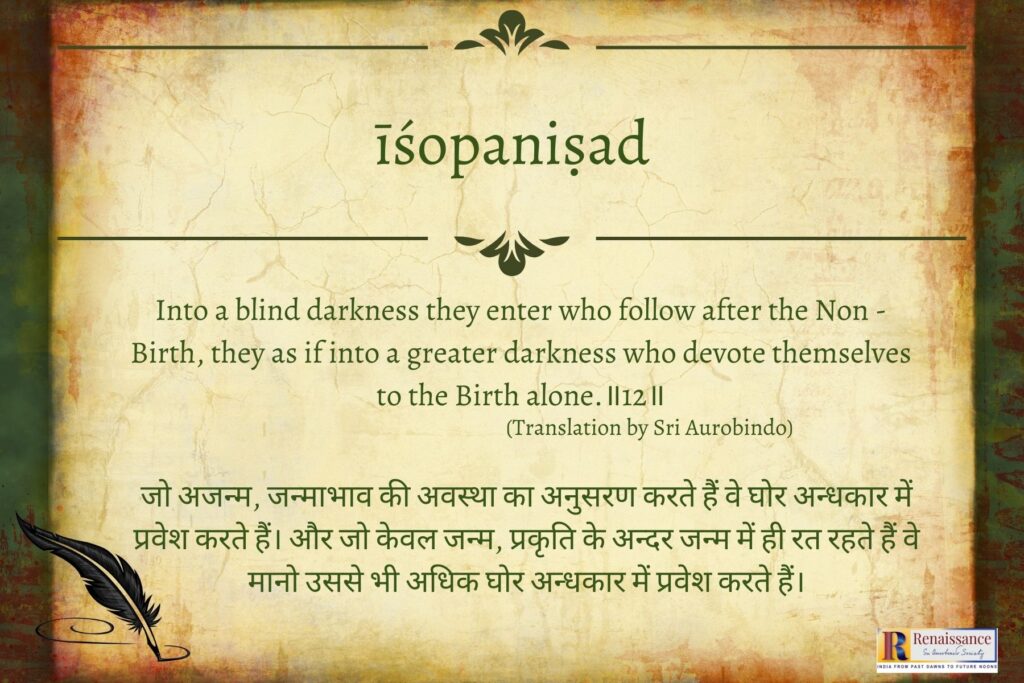
अन्धं तमः प्रविशन्ति येऽसम्भूतिमुपासते।
ततो भूय इव ते तमो य उ सम्भूत्यां रताः ॥१२॥
andhaṁ tamaḥ praviśanti ye’sambhūtimupāsate |
tato bhūya iva te tamo ya u sambhūtyāṁ ratāḥ ||
“Into a blind darkness they enter who follow after the Non-Birth, they as if into a greater darkness who devote themselves to the Birth alone.” (CWSA, Vol. 17, p. 8)
अन्यदेवाहुः सम्भवादन्यदाहुरसम्भवात् ।
इति शुश्रुम धीराणां ये नस्तद् विचचक्षिरे ॥१३॥
anyadevāhuḥ sambhavādanyadāhurasambhavāt |
iti śuśruma dhīrāṇāṁ ye nastadvicacakṣire ||
“Other, verily, it is said, is that which comes by the Birth, other that which comes by the Non-Birth; this is the lore we have received from the wise who revealed That to our understanding.” (CWSA, Vol. 17, pp. 8-9)
सम्भूतिञ्च विनाशञ्च यस्तद्वेदोभयं सह।
विनाशेन मृत्युं तीर्त्वा सम्भूत्याऽमृतमश्नुते ॥१४॥
sambhūtiñca vināśañca yastadvedobhayaṁ saha |
vināśena mṛtyuṁ tīrtvā sambhūtyā’mṛtamaśnute ||
“He who knows That as both in one, the Birth and the dissolution of Birth, by the dissolution crosses beyond death and by the Birth enjoys Immortality.” (CWSA, Vol. 17, p. 9)
Sambhuti and Asambhuti, Birth and non-Birth, Sri Aurobindo clarifies, are not so much conditions of the body as states of the soul. One who chooses the state of Non-Birth rejects Birth and the line of manifestation and prepares himself to withdraw into a non-being, goes to a Nihil, a Void where all is blank.
But he who is content to remain in the Birth alone, in the field of multiplicity and movement, without realising the saving truth of freedom and transcendence from Birth, goes under in an abysm of darkness. Both Birth and Non-Birth are facts of Existence, and both are to be integrated in oneself.
The lynch-pin that holds together the continually changing movements and experiences in the normal life of the individual is the ego-sense. When that is dissolved the main prop of the life in ignorance is destroyed, vināśa . It does not mean the end of the body; the physical frame can very well continue after the death of the ego. The seeker breaks the bonds imposed by the self-limiting ego, the subjection to incapacity, limitation and desire which are the agents of death.
And once he realises this freedom, the seeker after the integral truth of manifestation accepts the Birth: the soul chooses to participate in the general manifestation in order to more fully enjoy its freedom. As Sri Aurobindo says,
“. . . it is enjoyed by a free and divine becoming in the universe and not outside the universe; for there it is always possessed, but here in the material body it is to be worked out and enjoyed by the divine Inhabitant under circumstances that are in appearance the most opposite to its terms, in the life of the individual and in the multiple life of the universe.“
(CWSA, Vol. 17, p. 63)
To close this part, let us recall a passage from Sri Aurobindo’s ‘The Life Divine’ (chapter titled ‘The Destiny of the Individual’) where he summarises the essence of these six verses of Isha Upanishad as follows:
“Through Avidya, the Multiplicity, lies our path out of the transitional egoistic self-expression in which death and suffering predominate; through Vidya consenting with Avidya by the perfect sense of oneness even in that multiplicity, we enjoy integrally the immortality and the beatitude. By attaining to the Unborn beyond all becoming we are liberated from this lower birth and death; by accepting the Becoming freely as the Divine, we invade mortality with the immortal beatitude and become luminous centres of its conscious self-expression in humanity.”
(CWSA, Vol. 21, p. 46)

To be continued…
Read previous parts: Part 1, Part 2, Part 3
~ Graphic design: Biswajita Mohapatra

